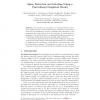Free Online Productivity Tools
i2Speak
i2Symbol
i2OCR
iTex2Img
iWeb2Print
iWeb2Shot
i2Type
iPdf2Split
iPdf2Merge
i2Bopomofo
i2Arabic
i2Style
i2Image
i2PDF
iLatex2Rtf
Sci2ools
IPMI
2007
Springer
2007
Springer
Spine Detection and Labeling Using a Parts-Based Graphical Model
Abstract. The detection and extraction of complex anatomical structures usually involves a trade-off between the complexity of local feature extraction and classification, and the complexity and performance of the subsequent structural inference from the viewpoint of combinatorial optimization. Concerning the latter, computationally efficient methods are of particular interest that return the globally-optimal structure. We present an efficient method for part-based localization of anatomical structures which embeds contextual shape knowledge in a probabilistic graphical model. It allows for robust detection even when some of the part detections are missing. The application scenario for our statistical evaluation is spine detection and labeling in magnetic resonance images.
Anatomical Structures | Complex Anatomical Structures | Efficient Method | IPMI 2007 | Medical Imaging |
| Added | 08 Jun 2010 |
| Updated | 08 Jun 2010 |
| Type | Conference |
| Year | 2007 |
| Where | IPMI |
| Authors | Stefan Schmidt, Jörg H. Kappes, Martin Bergtholdt, Vladimir Pekar, Sebastian P. M. Dries, Daniel Bystrov, Christoph Schnörr |
Comments (0)

